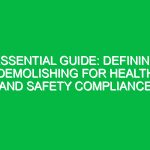# Protect Your Team: Understanding Hazardous Chemicals’ Four Entry Routes
Welcome, team! Today, we’re going to delve into a crucial topic that directly impacts your safety and well-being at work: Hazardous Chemicals- Four Routes of Entry. Understanding how these chemicals can enter your body is essential for preventing accidents and maintaining a secure working environment. So, let’s equip ourselves with the knowledge and awareness needed to protect ourselves and our team.
## The Four Routes of Entry for Hazardous Chemicals
When we talk about the four routes of entry for hazardous chemicals, we are referring to the ways in which these substances can enter our bodies and potentially cause harm. The four primary routes of entry include:
### 1. Inhalation
One of the most common ways hazardous chemicals can enter your body is through inhalation. When you breathe in fumes, vapors, dust, or gases containing these chemicals, they can be absorbed into your respiratory system and eventually enter your bloodstream. This route is particularly concerning as it can lead to respiratory issues, lung damage, and other serious health problems.
### 2. Ingestion
Ingestion occurs when hazardous chemicals are swallowed or consumed accidentally. This route of entry can occur if proper hygiene practices are not followed, such as eating or drinking in contaminated areas, or if hands are not washed before meals. Ingesting hazardous chemicals can result in gastrointestinal issues, poisoning, and other harmful effects on your body.
### 3. Dermal Absorption
Dermal absorption involves the direct contact of hazardous chemicals with your skin. These substances can be absorbed through the skin and enter your bloodstream, causing skin irritation, burns, allergic reactions, or systemic toxicity. It is crucial to use appropriate personal protective equipment (PPE) to minimize skin contact with hazardous chemicals and prevent absorption.
### 4. Injection
Although less common, injection can occur when hazardous chemicals penetrate the skin through cuts, punctures, or needle sticks. This route of entry is often associated with healthcare settings or industrial accidents involving sharp objects contaminated with chemicals. Injection can lead to immediate health risks, infections, and severe complications if not promptly addressed.
Now that we have a clear understanding of the four routes of entry for hazardous chemicals, it is vital to recognize the significance of taking preventive measures to mitigate these risks in our daily operations.
## Importance of Hazardous Chemicals- Four Routes of Entry in HSE
Incorporating knowledge about the four routes of entry for hazardous chemicals into our Health, Safety, and Environment (HSE) practices is crucial for several reasons:
– **Prevent Accidents:** By understanding how hazardous chemicals can enter our bodies, we can proactively implement measures to prevent accidents and exposure.
– **Promote Safety:** Awareness of the four routes of entry allows us to prioritize safety protocols, use appropriate PPE, and take necessary precautions to safeguard ourselves and our team.
– **Maintain Compliance:** Adhering to HSE guidelines and best practices related to hazardous chemicals ensures compliance with regulations and standards, reducing the risk of legal implications and penalties.
## Best Practices for Protecting Your Team
To protect ourselves and our team members from the risks associated with hazardous chemicals, it is essential to follow these best practices:
1. **Proper Ventilation:** Ensure adequate ventilation in work areas to minimize inhalation exposure to hazardous fumes or gases.
2. **Personal Protective Equipment (PPE):** Wear appropriate PPE, including respiratory protection, gloves, goggles, and protective clothing, to prevent skin contact and inhalation of hazardous chemicals.
3. **Hygiene Practices:** Practice good hygiene by washing hands thoroughly before eating, drinking, or touching your face to prevent ingestion of chemicals.
4. **Safe Handling:** Follow proper handling procedures for hazardous chemicals, including labeling, storage, and disposal to prevent spills or leaks that could lead to exposure.
5. **Training and Education:** Provide comprehensive training to all team members on the risks associated with hazardous chemicals, the four routes of entry, and the correct use of PPE and safety protocols.
By incorporating these best practices into our daily operations and remaining vigilant about the potential risks of hazardous chemicals, we can create a safer and healthier work environment for everyone.
## Conclusion
In conclusion, understanding the four routes of entry for hazardous chemicals is paramount in ensuring the safety and well-being of our team. By recognizing how these substances can enter our bodies through inhalation, ingestion, dermal absorption, and injection, we can take proactive steps to minimize exposure and prevent accidents.
Thank you for your attention and commitment to safety. Let’s continue to prioritize HSE practices, protect each other, and work together to maintain a secure and healthy workplace environment. Remember, your safety is our top priority. Stay informed, stay safe, and stay vigilant.
Let’s protect our team by understanding and addressing the risks associated with hazardous chemicals. Together, we can create a safer and healthier work environment for everyone.
Stay safe, team!
**Keywords:** toolbox talk, Hazardous Chemicals- Four Routes of Entry, HSE, safety protocols, PPE, prevention, best practices.


